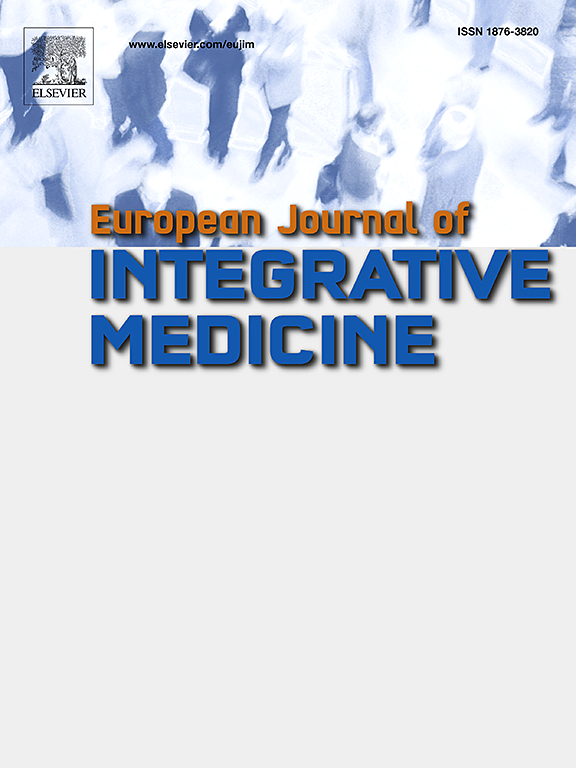通过直接和间接证据研究卡卡杜梅的光防护潜力:范围综述
IF 1.7
4区 医学
Q3 INTEGRATIVE & COMPLEMENTARY MEDICINE
引用次数: 0
摘要
澳大利亚是世界上晒伤率最高的国家之一。众所周知,澳大利亚本土植物具有独特的植物化学特征,对这种损害具有潜在的保护作用。Kakadu Plum (Terminalia ferdinandiana Exell),传统上由澳大利亚土著居民使用,以其异常高浓度的维生素C和多种酚类化合物而闻名。这篇综述的目的是综合现有的证据关于卡卡杜梅作为局部干预光损伤一级预防的功效。方法采用JBI证据综合手册,报告采用PRISMA扩展范围评价指南。在MEDLINE、PubMed、Embase、Scopus、谷歌Scholar和农业科学数据库等多个数据库中进行了全面的检索,收集了过去20年(2005-2025)卡卡杜李子光防护潜力和维生素C浓度的直接和间接数据。结果共发现31项临床前研究。只有1项研究直接在动物模型中检测了卡卡杜梅的光保护作用,22项研究提供了间接光保护机制的证据,包括抗氧化和抗炎作用,8项研究专门报道了维生素C含量。结论枸杞中维生素C含量高,为枸杞具有潜在的光防护作用提供了有力的间接证据。然而,由于缺乏直接的实验或临床证据,无法对其疗效得出明确的结论。因此,卡卡杜梅可能是一种未被充分开发的自然资源,值得对其光保护机制和治疗潜力进行进一步研究。冼周由西悉尼大学研究支持奖学金资助。本文章由计算机程序翻译,如有差异,请以英文原文为准。
Examining the potential of terminalisa ferdinandiana Exell (Kakadu Plum) in photoprotection through direct and indirect evidence: A scoping review
Introduction
Australia has some of the highest rates of sun-related skin damage in the world. Native Australian flora is known to possess unique phytochemical profiles with potential protective effects against such damage. The Kakadu Plum (Terminalia ferdinandiana Exell), traditionally utilized by Indigenous Australians, is notable for its exceptionally high concentrations of vitamin C and diverse phenolic compounds. This scoping review aims to synthesise the available evidence regarding the efficacy of Kakadu Plum as a topical intervention for the primary prevention of photodamage.
Methods
The methodology was guided by the JBI Manual for Evidence Synthesis, and the reporting was guided by the PRISMA Extension for Scoping Reviews. A comprehensive search was conducted across multiple databases, including MEDLINE, PubMed, Embase, Scopus, Google Scholar, and the Agriculture Science Database, to gather direct and indirect data on Kakadu Plum's photoprotective potential and vitamin C concentrations over the past 20 years (2005–2025).
Results
A total of 31 preclinical studies were found. Only 1 study directly examined Kakadu Plum's photoprotective effect in an animal model, 22 studies provided evidence of indirect photoprotective mechanisms, including antioxidant and anti-inflammatory effects, and 8 studies exclusively reported on the vitamin C content.
Conclusion
The results demonstrated exceptionally high vitamin C concentrations, providing strong indirect evidence of Kakadu Plum's potential photoprotective effect. However, the absence of direct experimental or clinical evidence precludes definitive conclusions regarding its efficacy. Kakadu Plum, therefore, may be an underexplored natural resource, warranting further research into its photoprotective mechanisms and therapeutic potential.
Funding
Dr. Xian Zhou is supported by the Research Support Fellowship, Western Sydney University.
求助全文
通过发布文献求助,成功后即可免费获取论文全文。
去求助
来源期刊

European Journal of Integrative Medicine
INTEGRATIVE & COMPLEMENTARY MEDICINE-
CiteScore
4.70
自引率
4.00%
发文量
102
审稿时长
33 days
期刊介绍:
The European Journal of Integrative Medicine (EuJIM) considers manuscripts from a wide range of complementary and integrative health care disciplines, with a particular focus on whole systems approaches, public health, self management and traditional medical systems. The journal strives to connect conventional medicine and evidence based complementary medicine. We encourage submissions reporting research with relevance for integrative clinical practice and interprofessional education.
EuJIM aims to be of interest to both conventional and integrative audiences, including healthcare practitioners, researchers, health care organisations, educationalists, and all those who seek objective and critical information on integrative medicine. To achieve this aim EuJIM provides an innovative international and interdisciplinary platform linking researchers and clinicians.
The journal focuses primarily on original research articles including systematic reviews, randomized controlled trials, other clinical studies, qualitative, observational and epidemiological studies. In addition we welcome short reviews, opinion articles and contributions relating to health services and policy, health economics and psychology.
 求助内容:
求助内容: 应助结果提醒方式:
应助结果提醒方式:


